by Caroline Barratt and Gill Green
University of Essex; University of Essex
Sociological Research Online, 22 (1), 9
<http://www.socresonline.org.uk/22/1/9.html>
DOI: 10.5153/sro.4219
Received: 8 Jul 2016 | Accepted: 20 Jan 2017 | Published: 28 Feb 2017
Housing research and sociological research on 'home' has under-explored Houses in Multiple Occupation (HMOs) as a form of specific and relatively marginalised housing tenure. In this paper we utilise data collected through participant photography and interviews with vulnerable HMO residents in a seaside town to explore their experiences of homemaking in HMOs. Drawing on literatures on home, identity and wellbeing we explore how HMO residents create a home in the space in which they live and how where they live simultaneously moulds their sense of identity. Our analysis is based upon interviews with, and photographs taken by, HMO residents. We highlight how home is created and experienced in a setting where basic levels of privacy can be hard to maintain, where space is constrained, and where residents would often prefer to live elsewhere. The meaning of 'home' in a HMO is influenced by personal histories and circumstances, by the normative attitudes towards housing in the UK, as well as by the space itself. The impact that living in a HMO might have on a tenant's identity and as a consequence their wellbeing is therefore highly contextual – not solely due to the characteristics of the property itself and the stigma some associate with this housing type but as an outcome of how the tenants relate to the property given their own preferences, conditioning and previous housing experience. There was variation in the extent to which respondents wanted their room to reflect, project or build their identity.

|
| Picture 1. Anthony's Room |
'This is my life basically - my room…They're [the photographs] not very interesting but they mean a lot to me in other sorts of ways yeah? My whole life revolves around my room now', (Anthony, aged 56)
1.1 Secure, appropriate and safe housing is a key contributor to psychological wellbeing (Kearns et al 2000; Evans et al 2003; Pevalin et al; Clapham 2010). However, trends in the UK housing market are making it increasingly difficult, especially for low-income and single person households, to find suitable accommodation that meets the minimum legal requirements for housing standards in the PRS (Private Rented Sector) (as outlined in the Housing Act 2004), as well as suiting their own needs and preferences. In England in 2015 20.2% of households lived in the PRS compared with 10.1% in 2001 (Department for Communities and Local Government 2016) and the PRS is becoming an unavoidable long term option for increasing numbers of people including families (Wilcox and Perry 2014).This is linked to rising house prices, fuelled by a growing gap between housing supply and demand (Pawson & Wilcox 2013), making home ownership less accessible to households, and to a reduction in the supply of social housing (House of Commons 2013; Clapham et al. 2014; Hoolachan 2016). Additionally, changes in global finance in the wake of the Global Financial Crisis of 2008/2009 resulted in growth in property investment using 'Buy to Let' mortgages and this has significantly altered the way the PRS is structured (Kemp 2015). In their comprehensive report on the PRS, Rugg and Rhodes (2008) describe how the challenge of rising rents, insecure tenancies and low housing standards undermines the ability of households to access suitable housing. More recently, the capacity of rented accommodation to provide the same psychological benefits as home ownership has been called into question due to the lack of security and sense of ownership experienced by PRS tenants (Easthorpe 2014; Hoolachan 2016).
1.2 This paper focuses on one particular sub-sector of the PRS - Houses in Multiple Occupation (HMOs). The technical definition of a HMO is complex but in this paper we use the term to refer to properties in which three or more unrelated occupiers share bathrooms and toilets and sometimes kitchens whilst having their own bedroom. HMOs can take different forms, from large shared student houses to individual bedsits with shared facilities. In areas such as seaside towns, former holiday bed and breakfast accommodation, often situated in large buildings with numerous bedrooms, have been altered to provide HMO accommodation to make up the financial short fall of declining domestic tourist trade (Ward 2015). As a result, poor quality bedsits in HMOs can be found in coastal towns throughout the UK (Smith 2012). The low cost of HMO accommodation acts as a draw for state benefit claimants and others seeking low cost housing (Stewart & Meerabeau 2009;Office of the Deputy Prime Minister 2006; Beatty & Fothergill 2003; Smith 2012). These are generally of a lower standard than the accommodation of many students and young professionals who may choose to live with friends in shared houses (see Rugg & Quilgars (2015) and Heath & Cleaver (2003) for accounts of shared housing in the housing trajectory of young people). Our focus is on those on low incomes who may end up living in HMOs because of constrained choices and often in response to urgent housing need (Kemp & Rugg 2001; Centre for Housing Policy 2011; Green et al. 2015).
1.3 HMOs are currently regulated under the Housing Act 2004 and the Management of Houses in Multiple Occupation Regulations 2006. The Housing Act 2004 (Part 1) introduced the Housing Health and Safety Rating System (HHSRS), to replace the previously outdated statutory standard of fitness, as well as mandatory licensing for larger HMOs. HMO properties requiring a licence are those with three or more floors, which house five or more people from three or more separate households. Licensing was introduced in recognition of the potentially high risk nature of large HMO properties for residents as well as mitigating the impact of high densities of HMO properties, especially in cities with large student populations and seaside towns (Department of Communities and Local Government 2010; Agarwal & Brunt 2006, Smith 2012). However, the capacity of these regulations to protect residents, especially with regards to potential risk to the mental health of tenants has been called into question (Barratt et al. 2012; Green et al. 2015).
1.4 We have chosen to focus on HMOs in a deprived location because they are a type of housing that has become associated with poor housing quality, problematic impacts on local communities and vulnerable tenants. In low income areas HMOs are often utilised by people unable to afford self-contained accommodation in the PRS and who are not considered a priority for social housing. In this context, HMOs are often associated with poor quality housing that is accessed by vulnerable or problematic populations (Green et al. 2015; Shaw et al. 1998; Perry 2012; Rugg 2010). Housing Benefit changes introduced in 2011 saw reductions in rates of Local Housing Allowance (LHA), thus reducing the number of properties that housing benefit claimants could access. Of particular relevance to this study was that single people, aged 25-35, who had previously been entitled to the LHA rate for self-contained one-bedroom accommodation were now only entitled to the Shared Accommodation Rate (SAR) and would therefore be pushed into shared properties. This resulted in an average loss of £13.06 per week for those affected (Brewer et al 2014: 46). However, the impact was not just financial, Cole et al. (2016) found that the changes in SAR regulation increased the stigmatisation of renters in this age group amongst landlords as well as causing HMOs to been seen as a more problematic form of housing tenure. They state:
'The SAR changes have reinforced the symbolic denigration of the HMO sector and further marginalised those vulnerable tenants who rely on it in the absence of more suitable, affordable accommodation' (Cole et al. 2016: 7.6)
1.5 Low cost HMOs are linked to social exclusion as they attract disadvantaged groups in receipt of Housing Benefit into seaside towns with limited employment opportunities (Ward 2015). In these areas HMOs tend to attract vulnerable individuals such as ex-offenders, people with mental health problems and problematic drug and alcohol use (Shaw et al.1998). This creates what Stewart et al. (2013: 24) refer to as a 'concentration of need'. The Centre for Housing Policy (2011), in their study of under 35s living in HMOs, found that reports of low level criminal activity and drug taking in HMO properties were common, that females were likely to report feeling unsafe, and that HMOs were particularly problematic for vulnerable tenants particularly ex offenders, drug users and those with mental health problems who found it hard to continue their recovery whilst living in that environment. There is also a high level of surveillance and control of vulnerable tenants living in HMOs (Green at al. 2015). Given that context, HMOs are perceived as a less desirable form of housing, and a poorer option than self-contained rental accommodation in which basic facilities are private. Therefore, we expect there may be barriers to creating a home in HMOs that do not exist in other housing types.
1.6 The concept of home is culturally specific but generally in westernised society home is conceptualised as a place in which we can withdraw from the outside world and its surveillance (Kaika 2004). Mallet (2004) argues a house is not just a material building but is also a 'home', often described as 'a haven' or a private place offering social, psychological and cultural security. Home is a place in which we have a high degree of control over what happens and what we experience (Evans et al. 2003) and in which we are able to be ourselves (Kaika 2004). Research on the relationship between housing and health suggests that the importance of housing goes beyond its role as shelter from the external elements (O'Mahony 2013). There is evidence that people from a wide range of differing housing circumstances derive similar psycho-social benefits from the home, experiencing the home as a haven and as a site of autonomy (see Kearns et al. 2000).
1.7 The characterization of home as haven has, however, been critiqued as being an idealized, romanticized even nostalgic notion that is at odds with the reality of peoples' lived experience of home (Jones 2000; Wardaugh 1999). The home is not necessarily a secure, safe, free or regenerative space (Wright 1991). In light of more critical accounts of home, a more realistic picture of home life has now been painted which better reflects processes of exchange, negotiation and conflict which make up domestic life (Brickell 2012). Going further, for some individuals, for example for those suffering domestic violence or for disabled people in unsuitable properties, the home can be a place of danger (Imrie 2004).
1.8 Clapham (2011) identified two main ways in which housing impacts wellbeing, firstly through facilitating and containing the tasks of day to day living and secondly through more subjective aspects such as self actualisation. Clapham (2010) emphasised the need for housing policy to move beyond aggregates and standardisation which prioritise the assessment of physical risks and hazards in properties to incorporate meaning and feeling. The link between home, wellbeing and identity has been theorised around philosophical notions of security (as opposed to material notions of security). Giddens (1990) invokes the idea of 'ontological security' to describe a psychological need for social and material constancy for human wellbeing, arguing that as human beings we act to construct a consistent framework of relationships and environment within which we live our lives. The notion of 'home' can therefore be considered primary in creating a sense of ontological security. Particular concerns have been raised about the impact of insecure tenancies in the PRS affecting the wellbeing of tenants because of a perceived persistent threat of possible disruption to the material constancy of individual's lives (Easthorpe 2014). Bone (2014) highlights how sociological and neuro-sociological research has come to show how insecure and unpredictable environments prevent the creation of a coherent sense of self and may lead to 'emotional alarm' and 'learned helplessness'.
1.9 Whilst the sense of having a 'home' can contribute to health and wellbeing, if someone's experience of living in a particular place does not match up to their notion of the normative guidelines defining a 'proper place to live', then there is a lack of ontological fit between one's residence and one's identity. This dissonance has been related to reduced psychological and physical wellbeing (Popay et al. 2003). The notion of ontological 'fit' and the link with individual housing biographies focuses on the relationship between place of residence and identity. The normative expectation is of home as a place where we should have the opportunity to personalise and make our own; One's house can be seen as an expression of the self, of who we are and what we value (Lewin 2001; Mallett 2004). Clapham notes that 'Clearly houses have a symbolic and discursive meaning at both societal and the individual level' (2011: 364).
1.10 The cultural meaning of home and the extent to which it is linked to identity is examined in McCracken's (2005) deconstruction of the concept of 'homeyness'. His typology, which is based on ethnographic work conducted in North America in the mid 1980s, identifies physical, symbolic and pragmatic properties of 'homeyness'. The symbolic property of 'homey' refers to the meaning and cultural significance of the domestic space. This encompasses a number of aspects ranging from 'fences, shrubbery and ornaments in private yards' (2005: 30) which 'contribute to a sense of enclosed space' (an embracing property) to 'trophies, gifts…photographs of the family, tourist momentoes' (2005: 34) which reflect historical meanings (mnomic properties). Ultimately, 'homeyness' as a situating aspect is when the resident 'becomes finally simply a part of the surrounding homey environment' (2005: 37), i.e. the home and the self are one. Through such symbolic properties 'homeyness' becomes for many people 'the adhesive that attaches them to self, family, time and place' (2005: 38). Pragmatic properties enable people to use the meaning of their home to project their identity and shape their relationship with wider society. Through these mechanisms and the creation of 'homeyness' in their domestic space, people are engaged in the creation of the self.
1.11 The field of material culture studies focuses upon the way people display, interact and talk about objects and things (Hurdley 2013, Miller 2010, Woodward 2007). As Miller (2010: 3) eloquently states, 'there are many good reasons why you should give a stuff about stuff' as 'things make people just as much as people make things' (Miller 2010: 135). The basic premise is that objects and their placement in the home signify things as they are tied to broader narratives of one's life and are very much part of people's sense of self' (Woodward 2007: 145). When we move home we sift through our 'stuff' and decide what to keep, what to throw away, what to unpack and what and how to display it in our new home. This process is an important part of how we create and reaffirm our identity (Miller 2010).
1.12 The nexus between identity and home is also the focus of Hurdley's (2006) examination of how private experiences of the self are manifested in the objects and artefacts that people display in the home. The objects, photographs and artefacts found on mantelpieces or display shelves are a focal point where family and individual stories are constructed. Artefacts such as a photo or a home-crafted gift from a child can both demonstrate an aspect of the self and become a site through which discussion about one's identity can be initiated. In this manner the way in which people display and talk about their possessions is part of identity-building contributing to the construction of autobiography.
1.13 In recognition, that much of her empirical data came from mantelpieces belonging to white middle classes, Hurdley (2013) extended her work to more diverse groups of people. She noted that some of the participants in her study, such as destitute asylum seekers, 'had no things with which to display memory, and no home of their own to present a face to the world' (2013: 7). This is particularly relevant to residents living in HMOs who may have few possessions and limited space in which to display them in their home, which may limit the extent to which they can use their 'stuff' to project their identity.
1.14 Easthorpe (2014) considered the ability of those in private rented accommodation to make their house a home. She found that security of tenure and the ability of tenants to make changes and effectively maintain the property in which they lived were important contributing factors to whether or not tenants reported they were able to make the property feel like a 'home'. It is likely that HMO tenants face even greater challenges in homemaking, compared with those in self-contained private rented accommodation because of the sharing of basic facilities which may further constrain their ability to perform the rituals of life in the way they wish.
1.15 Miller (2010) links housing to power and quotes Burkikova's study of Slovak au pairs in London. She found that half of their rooms were furnished with white melanine IKEA furniture, which 'Just like the au pair herself… is generally seen as inexpensive, generically European in a young modern poise, characterised by cleanliness, functionality and efficiency' (Miller 2010: 90). The furnishings of most HMOs are cheap and basic, projecting what landlords' perceive to be appropriate for their tenants as well as the temporary nature of many HMO tenancies. HMO residents may have little control over the furniture in their room and rarely have sufficient space to introduce new items.
1.16 In HMO accommodation tenants have a limited area to which they have sole access, usually just their room, with little or no control over who enters the property as a whole and they typically share bathrooms and/or kitchens with other tenants. The close proximity of living quarters means that tenants are frequently exposed to the behaviour of their neighbours through noise for example or cigarette smoke. In this context HMO accommodation can be seen to fall short of some of the normative ideals of what a home should be in terms of providing a place of privacy. This presents challenges for the tenant in terms of creating a 'homey' space (McCracken 2005). Furthermore, because of the often transient life styles of some HMO tenants (Shaw et al. 1998; Stewart et al. 2013; Centre for Housing Policy 2011) and the lack of control that HMO tenants have over their environment (Donson & Georges 1967) their ability to personalise their living environment, a process often associated with creating a 'home' (Easthorpe 2014; McCracken 2005), may also be relatively constrained.
1.17 We suggest that the questions of homemaking are particularly pertinent in relation to HMOs and yet there has been little research on this subsection of the PRS. The quote from Anthony (above) demonstrates that although HMOs may be somewhat distant from the normative ideal of 'home', this does not preclude tenants from ascribing a status of home to that place and it is this issue that we seek to explore further in this paper. We do this through exploration of three research questions:
- What evidence is there of homemaking amongst HMO tenants?
- What are the key factors which constrain the homemaking of HMO tenants?
- How does living in a HMO affect the sense of identity and wellbeing of HMO tenants?
2.1 The data collection took place as part of larger study on the experience of vulnerable HMO residents in a seaside town. In total, twenty HMO residents participated in biographical semi-structured interviews that took place between May and September 2011 (before the changes reducing the amount of Housing Benefit had been implemented).
2.2 Six of the respondents took part in a participatory photography exercise. Respondents who were transitory and did not know if they would be remaining in the area were not asked to participate in the photography element. We therefore recognise that the data discussed here comes from a relatively stable HMO population and therefore may not accurately represent typical HMO tenants. A visual methodology was selected due to the importance of the visual experience of place, space and especially home. The potential role of the visual image to enhance our understanding of place is described clearly by Gieryn (2000: 483) who remarks:
'…What I lacked were tools to analyse place in its given two or three dimensions. I am a victim, perhaps of trained incompetence in a discipline that cultivates statistics and words as a means to grasp the social…visualising (I think) is the next step'
2.3 The method chosen for this research was inspired by the Photovoice methodology. This is a form of participatory research which aims to empower marginalised social groups and typically utilises existing community groups, whose members are given basic photography training and are provided with equipment to take photos (Photovoice n.d.). Wang and Burris (1994) describe how the Photovoice method initially works at the individual level, increasing self-worth through participation. Then it shifts to the community with the aim of improving quality of life and lastly to the institutional level, enacting policy change. Within this project we only achieved the first of these in any meaningful way. Due to the high level of vulnerability amongst participants it was decided that individual interviews and one to one photo elicitation posed less risk to participants and overcame some of the ethical challenges of participatory photographic research by ensuring that the photos were only viewed within a confidential, one to one setting. Harper (2002) describes how photo elicitation can help to access different information from verbal interviews alone and we felt that that may be particularly true in the context of researching how participant's experienced where they lived, something that was likely to be, at least to some degree, familiar and taken for granted. The process of taking the photos and then reviewing them was to some extent resituating them from where they lived, as external observer.
2.4 Due to time and budgetary constraints we provided participants, who agreed to take part, with disposable cameras, which they were instructed to use by the researcher at the end of their first interview. Participants were asked to take pictures of where they lived. It was suggested that this might include things that they particularly liked or didn't like or things or places which meant something to them. They were warned against photographing others without their permission. Participants were given a week to take their photographs and were told that they could take up to 36 images (the maximum number in the camera). A one to one follow up interview, which included photo elicitation, provided each participant with the opportunity to describe and explain their own photos. Participants responded well to the task. The images they took allowed for discussion about issues that went beyond the concerns of the researcher, enabling participants to bring issues that concerned them into the research. In this sense, the project led to a degree of empowerment on the individual level but it lacked the direct wider community impact that Photovoice aspires to.
2.5 The analysis in this paper draws from the corpus of 20 interviews, but the main analytical emphasis is on the six participants in the Photovoice group. As researchers we first independently reviewed all of the photos identifying similarities and differences between the images and noting any themes which emerged. We independently reviewed them again in conjunction with the accompanying interviews and through discussion between ourselves and with support from other colleagues, agreed on the final analysis presented in this paper Table 1 lists the participants that took part in the photography aspect of the project. All the names are pseudonyms. Unfortunately, no follow up interview could be arranged with Anna. It should be noted that at the time of interview, Anthony was not sharing any facilities (which we included in our definition of HMO). However, he was included in the analysis as he had previously lived in a room in the same HMO without his own bathroom and was able to reflect upon the difference this made. Sheila and Anthony lived in the same property. All other respondents lived in different properties.
| Table 1. Details of respondents (Anonymised) |

|
2.6 The presentation of the results has been framed by the data analysis and the themes which emerged from thematic analysis of the photos and the interviews with tenants. We first explore the activities of homemaking that are evident in how the participants utilised the space in which they lived and the role and significance of possessions. We then consider how activities and homemaking is constrained and shaped by space, time, lack of privacy and safety. Lastly, we consider how the experience of living in a HMO may affect the sense of identity of tenants and the possible consequences for their wellbeing.
3.1 One way in which home life has been studied using visual methodology is through observing how space is utilised, where possessions are located and where daily activities take place (Arnold et al 2012). In this section we use the participant's photos as the basis for our discussion of homemaking in HMOs.
3.2 McCracken (2005) notes that a place that looks 'lived in' contributes to a sense of homey-ness, but the participants in our research felt that given the confined space of their room it was hard to prevent a room looking messy and disordered rather than comfortably 'lived in'. The prominence of personal possessions in the photographs may be more reflective of a lack of space and storage rather than an active engagement in trying to create a more homely environment.

|
| Picture 2. Mark's Room |
3.3 Mark (who took picture 2) mentioned to me informally after his interview that he was shocked about how messy his room appeared in the pictures and that he had actually tidied up before taking them suggesting that he had wanted to portray his home in a particular way.

|
| Picture 3. Sheila's Room |
3.4 In her interview, Sheila (picture 3) offered a discussion of the limited storage and space in the room, demonstrating a frustration with living in one room and how she tries to live within the constraints of the physical space:
'The problem is there is such a limited area to put things, so sometimes I have to put my towel on the chair when I use up all my hooks. I don't like just dumping things like that you know but when you're in a bedsit there's a very limited area you can put things.'
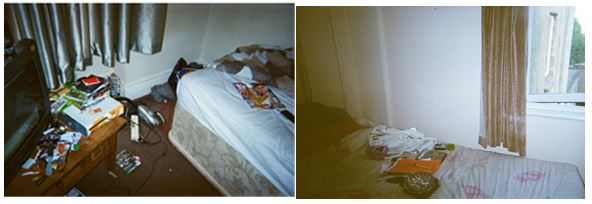
|
| Picture 4 and Picture 5. Dave's Room and Chantel's Room |
3.5 Similarly, the piles of eclectic items in picture 4 and the items on the bed (in picture 5 as well) suggest the difficulty of creating a comfortably 'lived in' homey-ness within a confined space. This limitation can create tension between different aspects of homemaking – on the one hand creating conditions that facilitate and contain the tasks of day to day living whilst on the other being able to personalise and express identity (Clapham 2011).
3.6 Sheila's image of the kitchen area in her room (picture 3) illustrates her attempts to delineate the space for specific tasks, thereby facilitating day-to-day living.
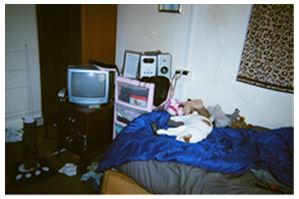
|
| Picture 6. Anna's Room |
3.7 In Anna's photograph (picture 6) we can see that she has a cat, which might be seen to intensify the pressure on the limited space that she has, thereby negatively impacting upon day-to-day living, but positively, might be regarded as a homemaking act and one that imposes her own identity upon the property. Anna described her cat as having real meaning to her and significantly contributed to her wellbeing:
'he means everything to me, my cat – he's my life – and I have to think of him. He's like a child to me. He's like the child I never had. And then I've got to think of him, get him a nice place with a nice little garden, and just put roots down somewhere'
3.8 When discussing the possessions that featured in the photos the importance of using the possessions in their rooms to help pass the time became evident. Dave reported that his x-box (see picture 4) helped to keep him 'out of trouble'. He reported that he 'nearly cried' when his previous x-box was stolen from where he used to live.
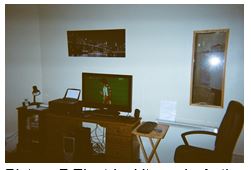
|
| Picture 7. Electrical items in Anthony's room |
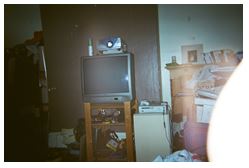
|
| Picture 8. Projector, TV, fridge and games console in Mark's room |
3.9 Mark also reported spending a lot of time in his room watching TV (picture 8). Similarly, for Anthony (picture 7) the use of the electrical equipment including his computer and TV was a way of helping him to pass the time and maintain a positive frame of mind:
'From the telly I've got a computer, an all in one printer that scans as well, so I've got all that sort of thing as well now that I didn't have before, which keeps me busy during the day…If I didn't have these sort of things to do I'd probably get depressed again but if I get fed up with TV I can go on the computer…I put my music on and play, like, solitaire, [it] keeps me going'
3.10 For Anthony, whilst he focuses on the usefulness of his possessions, they also seemed to symbolise a transition in his life and moving to his new room.
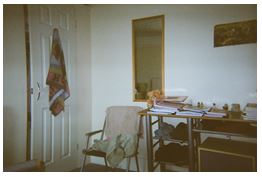
|
| Picture 9. Teddy and Napoleon picture in Sheila's Room |
3.11 For Sheila (picture 9), her acquisition of objects manifested in the personalisation of her room. She particularly liked buying teddies and ornaments and had an interest in history. There is an image of the Napoleonic wars on her wall which she cut had out from a magazine. Yet despite the problem of limited space described above Sheila reported that she '…used to buy things in the past, to decorate the room up you know?'
3.12 The possessions that people had and the act of obtaining those possessions therefore played an important part in helping tenants pass the time within their constrained space and budget. There was evidence that two participants also used their possessions to personalise the space in which they lived or reorganised the way furniture and possessions were arranged to try and put their own mark on the property. It was notable however that the possessions most in evidence were not very personal in nature, for example only one of all of the photos collected contained a personal photo (picture 8). Arnold et al. (2012: 135) note that wanting to surround ourselves with things that we value may be a 'human universal'. In the photos collected in this study it seems that many of the items that can be seen are valued because of their use value – they are functional in some way, with items that helped to pass the time being particularly prominent. Even in the case of Sheila, who explicitly reported trying to decorate and personalise her room, she reported that she did this as much as an activity to help pass the time as to create a home. The display of possessions as an expression of identity as described by Hurdley (2006) to project one's identity is largely absent. This may be a consequence of the constraints discussed in the following section.
4.1 Tucker (2012) notes that present housing environments reflect anticipation for the future. For all of the respondents (except for Anthony, picture 7, whose room was tidy and ordered), HMOs were not considered as a permanent housing choice. They hoped for change. As such, life in the HMO might be ordered around approaches that facilitate day-to-day living, and that actually downplay notions of identity
4.2 Anna, who was living in a HMO that she described as a 'hotel' (hotel was in the name of the property), stated that 'a hotel isn't a stable place to be. It's not a permanent place – in my opinion, anyway'. It is worthy of note that in this example Anna combines issues of temporality with issues of stability. This issue of stability, (whilst unqualified) could speak to wider issues of self-actualisation. Altering the number of possessions they had in order to live effectively within the limited space or making it too homey and too closely infused with their identity would be an admittance that they were committed to this place, that they had in effect identified with living there. Chantel explained how she would be able to utilise space differently if she were in her own flat: 'I can hang things I can make it look nice, I can have things up on the walls. Here it's only one room. I move this room around a lot but I have to remind myself that the room is still going to look the same!'. This suggests that the limited space and the very limited opportunities she had to personalise the space led to her feeling constrained in her ability to express her identity and convert her room into a home.
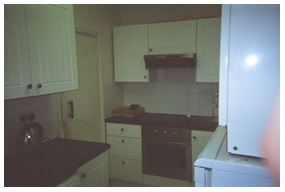
|
| Picture 10. Mark's shared kitchen showing the cooker and door to the bathroom |
4.3 One of the most notable features of living in a HMO is that many daily tasks are carried out in shared areas such as bathrooms or kitchens although some tenants had a small kitchen area in their rooms. Sheila's private kitchen (picture 3) within her bedroom features many items not typically associated with kitchen activities. For example, the presence of a mirror and a bath towel drying in the corner, suggest the use of this area for personal grooming. In contrast Mark's shared kitchen (picture 10) is bare and impersonal and not in any sense 'homey' reflecting the difficulty of having personal possessions or identifiers in a shared space. Regarding the challenge of sharing a kitchen Mark notes: 'when you do live that close to somebody you, you always do find a way of living with them… developing your own rules without actually speaking about them'. This illustrates the work required, in this case tacit negotiation, in order to carry out necessary tasks within the constraints that exist and maintain harmonious relationship with others. Although in self-contained accommodation we may share with other people, we typically have more control over who they are and who we engage with in our homemaking. In HMOs tenants have very little or no control over who lives in the property which may lead to increased stress and a lack of homeliness if they do not build positive relationships with those they share with.
4.4 Of the respondents only Anthony had his own bathroom (picture 11). Anthony had been allocated an en-suite room when his physical disabilities prevented him from using the shared facilities. It is notable that because this is a private bathroom items, such as shower gel and a towel can be seen; these are absent from the images of shared bathrooms in other properties.
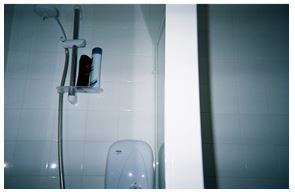
|
| Picture 11. Anthony's en-suite shower, with shower gel and shampoo |
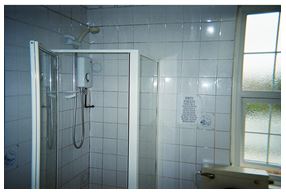
|
| Picture 12. Dave's shared bathroom. |

|
| The sign on the wall states |
4.5 Having to share toilet and showering facilities means that traditionally private activities take place in a quasi-public domain. Dave in particular, graphically described the state in which the bathroom was often left and took picture 12 of the sign on the bathroom asking tenants to leave it clean. Both Sheila and Anthony (before he had en suite facilities) reported times when they had feared going to the bathroom because they were apprehensive about leaving their bedroom due the activities of other tenants and their guests, for example fighting in the hallway.
4.6 Twigg (1999) describes how domestic space is organised on a public/private axis and that there is a privacy gradient in which halls are more public than living rooms which, in turn, are more public than bedrooms. Within a HMO this public/private axis is different. There is limited opportunity for a 'gradient' - the hall space is open to all who live in the property as are the shared facilities. The only truly private space that a HMO resident had was their bedroom. Living in a HMO forces a degree of intimacy on people who do not know each other and have not chosen to live together. Expressing oneself within such a setting through personalising space may not only be constrained by the space itself but also by a sense of vulnerability about the extent to which they wished to be known by others in the property.
4.7 When talking to Chantel about the image she had taken of the front door of the property I asked how she felt about the image:
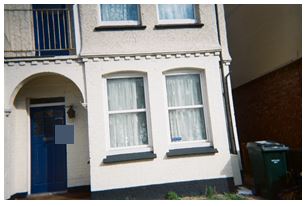
|
| Picture 13. Chantel's front door (square is covering door number) |
Chantel: That's my home Interviewer: And is that a positive feeling? Chantel: Yes and no cause it's not just my home is it? It's other people's home but I would like to call it my home.
4.8 Because it was the home of others too, the image was considered less positive despite Chantel reporting having made positive relationships with the tenants within the property. Chantel also commented that she loved her bed because it is the place that was only hers and no one else could enter it – suggesting that even her bedroom felt as though it was in the public domain. However, Mark remarked that the door to the property represented the ability to 'shut out the rest of the world' which indicates that, that space, although perhaps compromised when looked at from the perspective of other housing tenures does offer a degree of privacy, security and sanctuary. It is difficult to predict how secure or private a space will feel from its physical characteristics alone, the personality and preferences of individual tenants and the social environment of the property are all likely to have an impact on this.
5.1 The interview data contained a number of references to how living in a HMO interacted with issues of identity and wellbeing. The notion of having a 'spoiled identity' (Goffman, 1963) by being identified as someone living in a HMO was a frequent response. Not only are HMOs far removed from the normative ideal of home as a sanctuary, but there is also stigma associated with the people who dwell in them. Anna clearly summarised her thoughts on people that lived in HMOs:
'But with regard to people in bed-sits, they are the underclass, they're usually unemployed, probably on drugs or alcoholic, most likely been in contact with the law – on the wrong side of it – at some stage, they're usually the people that nobody wants particularly, and there are certain types of landlords that accommodate for people like that. I salute those landlords, because most people don't want people like that. Don't want them in their shops, don't want them in the cafés, don't want them in their pubs, they might as well paint a big cross on their foreheads or something!'
5.2 This summary presents a range of stigmatised or spoiled identities, in terms of social class, lack of access to the labour market, issues of substance use, the criminal justice system, social exclusion, before invoking actual physical stigmata into the discussion. This statement functions very strongly to communicate the stigma associated with this type of living articulated by some of the participants, demonstrating an almost co-morbid level of stigmatisation around people who live in these types of dwellings. Feelings of stigma about where one lives are likely to impact on ontological security. The stigma and ontological discomfort of living in a HMO was articulated by Mark who, due to a rapid change of circumstances including unemployment, meant that living in a HMO was indicative of what he described as being 'knocked over' and 'back to square one'. The 'culture shock' he describes indicates that he doesn't feel as though he fits in and he was also keen to avoid visits from family and former friends who he felt may have stigmatising attitudes about HMOs. For Sheila, living in a HMO was not something that she was proud of and she consistently referred to her siblings who she perceived as more successful and more respected by her parents. She felt that her parents disapproved of where she lived but described how she could not afford to live elsewhere. Stigmatisation therefore contributed to the isolation of some HMO tenants.
5.3 Popay et al. (2003) emphasise the difficulty people can experience when there is discordance between the normative guidelines that a person has for a 'proper place to live' which in Mark's case was formulated by his experience of living in good quality self-contained accommodation in a large town, and for Sheila was formulated living in the family home owned by her parents. For them both there was considerable discordance that was reinforced by their families' reactions resulting in a sense of shame in living in a HMO. Furthermore, Bone (2014) highlights the potential for harm if a coherent sense of identity is lacking and how a consistent environment, which allows the development of meaningful attachment is central to identity formation and continuation.
5.4 However, for other participants, notably Chantel, Anthony and Dave, where they now live is indicative of a new and more positive stage in their lives. They talked less about dissonance or stigma associated with HMO life, and more about personal ontological comfort and fit. Although Chantel had previously lived in a self-contained flat she had experienced vandalism and threats whilst living there from street residents. So although her move to a HMO could be understood as a step backwards in terms of accommodation type she is actually much happier now. When I asked her about the property she stated: 'I'm happy yeah…it's a first 'cause I am always walking around like with a sour face, but I'm happy for once'. Anthony's room change four months prior to the interview appeared to have significantly affected his sense of identity in a positive way by enabling him to become more independent. Similarly, for Dave his HMO room is symbolic of a new stage in his life and he noted that, 'I'm a different person now'.
6.1 The experience of homemaking in HMOs varies among tenants and is influenced by the characteristics of where they live as well as their own context and life experience. At one extreme is Anthony who had recently moved to an en-suite room which enabled him to live independently. He had managed to create a home in a HMO where he is comfortable and his needs are catered for. At the other extreme is Mark who was in self-contained rental accommodation living with a partner and working prior to moving to HMO accommodation. He described a very difficult relationship with where he lives due to the difficult circumstances that led to him living there and the stigmatising attitudes that he perceived his family and friends would have towards HMO accommodation. Nevertheless, Mark reported feeling safe and protected from the world when he shut his door and all participants, even those who did not equate a HMO with being a 'home' or a 'proper place to live' (see Popay 2003) or said that they wanted to move into self-contained accommodation, displayed some attributes associated with homemaking. This would suggest that housing type is not necessarily crucial in deciding whether somewhere can be 'home'.
6.2 However, a number of constraints to homemaking were evident. These included the lack of physical space and storage; lack of control over the areas in which to carry out the activities of day-to-day life and the 'temporariness' of the accommodation – usually because the participants wished to move from where they were now living. HMO tenants thus had restricted space to create a homey environment, limited tenure and lack of control over much of their living space, particularly the shared spaces. All these attributes are noted in the literature described in the introduction as key to the creation of 'home'. It also became apparent that the housing choices that the HMO tenants had were limited, largely due to the financial constraints imposed by social and housing policy, and that this lack of agency in choosing where to live may also limit the sense in which the residence can feel like a home.
6.3 The photos do illustrate some activities of homemaking and personalisation and this also emerged in some of the interviews. However, in general, the possessions in the photos were very functional or images of things to pass the time. The participants took very few images of personal objects and artefacts, described by Hurdley (2006) as a way to express the self. We speculate that this was in part due to lack of display space and a lack of these types of possessions as well as lack of motivation to project one's identity. The limitations and exclusions of HMO living were largely reflected in the artefacts and objects photographed by the HMO residents in our study. They were predominantly functional and were usually not displayed in a way to project or create selfhood.
6.4 Variation was evident in the extent to which respondents wanted their room to project their identity and become their 'home'. For some tenants, there was a dissonance between how they perceived themselves, their sense of identity, and living in a HMO. This influenced the extent to which they invested in trying to create a home. This relates to the idea of 'ontological security' (Giddens 1990) and the psychological need for social and material constancy for human wellbeing. For many of those interviewed having to live in a HMO is a marker of material inconsistency and for some tenants it is also a marker of social inconsistency. The impact of HMOs on the identity and wellbeing of HMO tenants is associated with previous experience of housing and 'home' as well as the social and economic characteristics of their lives. For some participants moving into a HMO was symptomatic of challenging life circumstances. The strong negative conception of HMO tenants expressed by one of the participants highlights the stereotyping of tenants in this type of property and illustrates the potential for a 'spoiled identity' (Goffman 1963) amongst those who find themselves living in a HMO having previously lived in other housing types. For some at least it was important to retain a degree of dissonance between their self-identification as someone living in a HMO, and all the attendant stigma this might bring, which in turn acted as a barrier to making their room into their 'home' – in turn this could have multiple negative impacts upon levels of general health and wellbeing.
6.5 HMOs are of course not the only example of shared housing amongst groups living in relatively temporary housing. Heath & Cleaver (2003) examine the housing transitions of young adults which involve extensive periods of sharing with peers either as students or when entering the labour market. They differentiate the shared housing of the young adults they study from the 'bedsit' in HMOs as the former is based on at least a minimal level of sociability and mutual trust whereas the latter is not. Nevertheless, they conclude that there is a growing mismatch between popular conceptualisations of home and everyday lived experiences of many young adults in shared accommodation. This mismatch is in many ways even more apparent among the low income HMOs tenants who participated in our study. We suggest that HMO properties and HMO tenants in deprived areas are more marginalised (see also Barratt et al. 2015). That they are also subject to relatively high levels of surveillance and control (often couched in the language of care) from landlords further illustrates this point (see Green et al. 2015).
6.6 Whilst not the focus of this paper, it is also important not to ignore the wider political and economic context in which the participants were trying to create a home and how social and economic policy impact upon housing choice. The constraint of housing choice experienced by the participants was largely determined by what they could afford on the Housing Benefit, the level of which is decided by government. This research took place before the changes to Housing Benefit legislated in 2011 were implemented. We would therefore expect at least some members of this group to be worse off now and that the percentage of PRS tenants housed in HMOs to also have increased. Not being able to create a home can be injurious to wellbeing but still social welfare and housing policies fail to sufficiently value, and perhaps increasingly neglect, the importance of home. In light of this there is great need for further research on the experience of HMO tenants.
6.7 The importance of research on low-income neighbourhoods, such as the one in which these HMO tenants lived is an important aspect of housing research, McKee and Murry (2013: 5) in their summary of housing research state that 'conceptualizing the role of housing, both as a cause and a solution to social and spatial inequality becomes crucial. So too is the importance of feeding the views and experience of residents of low-income neighbourhoods into the research and policy process'. We feel that the use of participatory photography and photo elicitation interviews has been an important aspect of this study as it has enabled the accommodation to be seen through the eyes of the tenant. Whilst this particular study lacked a strong community element, often a feature of Photovoice research, we suggest that this would be a rich and useful future direction in housing research.
6.8 It appears that a home can be created in a HMO even though it may not fit with societal perceptions of what a 'real home' might look like. HMOs can be experienced as places of safety and privacy despite the apparent challenges of having to share basic facilities. What has emerged is that the cultural conception of home and the stigma associated with this housing type may contribute to the sense that a HMO is not a home, making to more difficult for those residing within them to relate positively with where they live. Ultimately, this may also influence the sense of identity of tenants, undermining their sense of themselves and acting to further marginalise them within society.
AGARWAL, S and Brunt P (2006). Social exclusion and English seaside resorts. Tourism Management Vol. 27, No. 4, p. 654-670.
ARNOLD, JE, Graesch A, Ochs E and Ragazzini E (2012) Life at Home in the Twenty-First Century: 32 Families Open Their Doors. Los Angeles: Cotsen Institute of Archaeology at UCLA.
BEATTY, C and Fothergill S (2003) The Seaside Economy: The Final Report of the Seaside Towns Research Project. Sheffield: Centre for Regional Economic and Social Research, Sheffield Hallam University.
BARRATT, C, Kitcher C and Stewart J (2012) Beyond safety to wellbeing: how local authorities can mitigate the mental health risks of living houses in multiple occupation. Journal of Environmental Health Research, Vol. 12, No. 1, p. 39-50.
BARRATT, C, Green G and Speed E (2015) Mental health and houses in multiple occupation. Journal of Public Mental Health Vol. 14, No. 2, p. 107-117.
BREWER, M, Emmerson C, Hood A and Joyce R (2014) Econometric Analysis of the Impacts of LHA reforms on Existing Claimants DWP Research Report 871. London: Department for Work and Pensions.
BRICKELL, K (2012) 'Mapping' and 'doing' critical geographies of home. Progress in Human Geography, Vol. 36, No. 2, p. 225-244.
BONE, J (2014) Neoliberal Nomads: Housing Insecurity and the Revival of Private Renting in the UK. Sociological Research Online, Vol. 19, No. 4.
CLAPHAM, D, Mackie P, Orford S, Thomas I and Buckley K (2014) The housing pathways of young people in the UK. Environment and Planning, Vol. 46, No. 8, p. 2016-2031.
CLAPHAM, D (2010) Happiness, well-being and housing policy. Policy and Politics, Vol. 38, No. 2, p. 253-267.
CLAPHAM, D (2011) The Embodied Use of the Material Home: an Affordance Approach. Housing, Theory and Society, Vol. 28, No. 4, p. 360-376.
CENTRE FOR HOUSING POLICY, University of York (2011) Unfair Shares - A report on the impact of extending the Shared Accommodation Rate of Housing Benefit. http://www.york.ac.uk/media/chp/documents/2011/unfairsharessummary.pdf Accessed 12 May 2014.
COLE, I, Powell R and Sanderson E (2016) Putting the Squeeze on 'Generation Rent': Housing Benefit Claimants in the Private Rented Sector - Transitions, Marginality and Stigmatisation, Sociological Research Online. Vol. 21, No. 2 http://www.socresonline.org.uk/21/2/9.html.
DEPARTMENT FOR COMMUNITIES AND LOCAL GOVERNMENT, (2010) Evaluation of the Impact of HMO Licensing and Selective Licensing. http://webarchive.nationalarchives.gov.uk/ 20120919132719/http:/www.communities.gov.uk/documents/housing/pdf/1446438.pdf Accessed 13 January 2017
DEPARTMENT FOR COMMUNITIES AND LOCAL GOVERNMENT, (2016) Dwelling Stock Estimates 2015 England. https://www.gov.uk/government/uploads/system/ uploads/attachment_data/file/519475/Dwelling_Stock_Estimates_2015_England.pdf Accessed 13 January 2017
DONSON, C and Georgés A (1967) Lonely-land: a panorama of loneliness, from childhood to the 'sun-set years,' and including Bedsitter-land: one-room living: a contribution towards a greater understanding and awareness of the loneliness scene and the problems of the Lonely. Wales: A.J. Chapple.
EASTHORPE, H (2014) Making a Rental Property Home. Housing Studies, Vol. 29, No. 5, p. 579-596.
EVANS, G, Wells N and Moch A (2003) Housing and mental health: A review of the evidence and a methodological and conceptual critique. Journal of Social Issues, Vol. 59, p. 475-500.
GIDDENS, A (1990) The Consequences of Modernity. Cambridge: Polity Press.
GIERYN, TF (2000) A Space for Place in Sociology. Annual Review of Sociology, Vol. 26, No. 1, p. 463-496.
GOFFMAN, E (1963) Stigma: notes on the management of a spoiled identity. London: Simon and Schuster.
GREEN, G, Barratt C and Wiltshire M (2015) Control and Care: Landlords and the Governance of Vulnerable Tenants in Houses in Multiple Occupation. Housing Studies, Vol. 31 No. 3 p. 269-286.
HARPER, D (2002) Talking about pictures: A case for photo elicitation. Visual Studies, Vol. 17, No. 1, p. 13-26. [doi:10.1080/14725860220137345]
HEATH, S and Cleaver E (2003) Young, Free and Single? Twenty-somethings and Household Change. Basingstoke & New York: Palgrave Macmillan.
HOUSE OF COMMONS, Communities and Local Government Committee (2013) The Private Rented Sector - First Report of Session 2013-14. London: The Stationery Office Limited.
HOOLACHAN, J, McKee K, Moore T and Soaita AM (2017) 'Generation rent' and the ability to 'settle down': economic and geographical variation in young people's housing transitions. Journal of Youth Studies, Vol. 20, No. 1, p. 63-78.
HURDLEY, R (2006) Dismantling Mantelpieces: Narrating Identities and Materializing Culture in the Home. Sociology Vol. 40, No. 4, p. 717-733. [doi:10.1177/0038038506065157]
HURDLEY, R (2013) Home, Materiality, memory and Belonging. Basingstoke & New York: Palgrave MacMillan.
IMRIE, R (2004) Disability, embodiment and the meaning of the home. Housing Studies, Vol. 19, No.5, p. 745-763. [doi:10.1080/0267303042000249189]
JONES, G (2000) Experimenting with Households and Inventing 'Home'. International Social Science Journal, Vol. 52, No. 2, p. 183-194.
KAIKA, M (2004) Interrogating the geographies of the familiar: domesticating nature and constructing the autonomy of the modern home. International Journal of Urban and Regional Research, Vol. 28, No. 2, p. 265-286. [doi:10.1111/j.0309-1317.2004.00519.x]
KEARNS A, Hiscock R, Ellaway A and Macintyre S (2000) 'Beyond Four Walls'. The Psycho-social Benefits of Home: Evidence from West Central Scotland. Housing Studies, Vol. 15, No. 3, p. 387-410.
KEMP, PA and Rugg J (2001) Young people, housing benefit and the risk society. Social Policy & Administration, Vol. 35, No. 6, p. 688-700. [doi:10.1111/1467-9515.00261]
KEMP, PA (2015) Private Renting After the Global Financial Crisis. Housing Studies, Vol. 30, No. 4, p. 601-20.
LEWIN, FA (2001) The Meaning of Home among Elderly Immigrants: Directions for Future Research and Theoretical Development. Housing Studies, Vol. 16, No. 3, p. 353-370. [doi:10.1080/02673030120049715]
MALLETT, S (2004) Understanding home: a critical review of the literature. The Sociological Review, Vol. 52, No.1, p. 62-89.
MCCRACKEN, GD (2005) Culture and Consumption II: Markets, Meaning, and Brand Management. Indiana University Press.
MCKEE, K and Muir J (2013) An Introduction to the Special Issue – Housing in Hard Times: Marginality, Inequality and Class. Housing, Theory and Society, Vol. 30, No. 1, p. 1-9.
MILLER, D (2010) Stuff. Cambridge: Polity Press.
OFFICE OF THE DEPUTY PRIME MINISTER, (2006) Housing, Planning, Local Government and the Regions Committee: Coastal Towns Session 2005-06, http://www.publications.parliament.uk/pa/cm200506/cmselect/cmodpm/1023/1023ii.pdf. Accessed 3 August 2012.
O'MAHONY, LF (2013) The meaning of home: from theory to practice. International Journal of Law in the Built Environment, Vol. 5, No. 2, p. 156-171. [doi:10.1108/IJLBE-11-2012-0024]
PAWSON, H and Wilcox S (2013) UK Housing Review. Chartered Institute of Housing. http://practice-online.cih.org/resources/PDF/Policy%20free%20download%20pdfs/ UKHR%202012%20Briefing%20Paper.pdf. Accessed 1 July 2016.
PEVALIN D, Taylor M and Todd J (2008)The Dynamics of Unhealthy Housing in the UK: A Panel Data Analysis. Housing Studies, Vol. 23, No. 5, p. 679-695. [doi:10.1080/02673030802253848]
PERRY, J (2012) UK migrants and the private rented sector. York: JRF http://www.jrf.org.uk/publications/uk-migrants-private-rented-sector Accessed 30 September 2016.
PHOTOVOICE, (n.d.) The PhotoVoice Manual. http://www.photovoice.org/PV_Manual.pdf. Accessed 8 May 2014.
POPAY, J, Thomas C, Williams G, Bennett S, Gatrell A and Bostock L (2003) A proper place to live: health inequalities, agency and the normative dimensions of space. Social Science & Medicine, Vol. 57, No. 1, p. 55-69.
RUGG, J and Rhodes D (2008). The private rented sector: its contribution and potential. York: Centre for Housing Policy, http://www.york.ac.uk/media/chp/documents/2008/prsreviewweb.pdf. Accessed 1 July 2016.
RUGG, J (2010) Young People and Housing: The Need for a New Policy Agenda. York: Joseph Rowntree Foundation.
RUGG, J.J. AND QUILGARS, D.J. (2015) Young people and housing:A review of the present policy and practice landscape, Youth and Policy. 5-16.
SCOTT, S (2009) Making Sense of Everyday Life. Cambridge, UK: Polity press.
SHAW, M, D Dorling and N Brimblecombe (1998). Health problems in houses in multiple occupation. Environmental Health Journal, Vol.106, No. 10, p. 280-281.
SMITH, D. (2012) The social and economic consequences of housing in multiple occupation (HMO) in UK coastal towns: geographies of segregation. Transactions of the Institute of British Geographers, Vol. 37, No. 3, p. 461-76.
STEWART, J and Meerabeau L (2009) Lay perceptions of health housing and community on the Kent coast, England. Journal of Environmental Health Research, Vol. 9, No. 2, p. 69-79.
STEWART, J, Rhoden M, Knight A, Mehmet N and Baxter L (2013) Beside the seaside: perceptions from the 'front line' on the support needs of families living in the private-rented sector in Margate. Journal of Environmental Health Research, Vol 13. p. 22-33.
TUCKER, I (2012) Organizing the present in anticipation of a better future: Bergson, Whitehead, and the life of a mental health service user. Theory Psychology, Vol. 22, p. 499-512. [doi:10.1177/0959354311424077]
TWIGG, J (1999) The spatial ordering of care: public and private in bathing support at home. Sociology of Health & Illness, Vol. 21, No. 4, p. 381-400.
WANG, C and Burris MA (1994) Empowerment through Photo Novella: Portraits of Participation. Health Education Quarterly, Vol. 21, No. 2, p. 171-86. [doi:10.1177/109019819402100204]
WARD, KJ (2015) Geographies of exclusion: Seaside towns and Houses in Multiple Occupancy. Journal of Rural Studies, Vol. 37, p. 96-107.
WARDAUGH, J (1999) The Unaccommodated Woman: Home, Homelessness and Identity. Sociological Review, Vol. 47, No. 1, p. 91-109. [doi:10.1111/1467-954x.00164]
WILCOX, S and Perry J (2014) UK Housing Review 2014. http://www.cih.org/publication/ display/vpathDCR/templatedata/cih/publication/data/UK_Housing_Review_2014 Accessed 30 September 2016
WOODWARD, I (2007) Understanding Material Culture. London: Sage. [doi:10.4135/9781446278987]
WRIGHT, G (1991) Prescribing the Model of Home. Social Research, Vol. 58, No 1, p. 213-225.